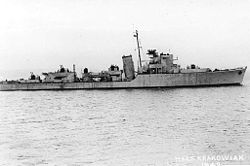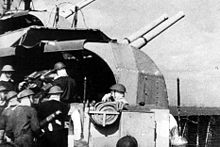ORP Krakowiak (L115)
|
The Krakowiak
|
||||||||||||||||||||||
|
||||||||||||||||||||||
|
||||||||||||||||||||||
|
||||||||||||||||||||||
|
||||||||||||||||||||||
ORP Krakowiak (L115) was a destroyer escort the British Hunt class , which in the Second World War, the Polish exile Navy has been asked by the Royal Navy are available. The warship was originally built as HMS Silverton (L115) for the British Navy , but was handed over to the Polish Navy before completion.
After the war ended, the ship was returned to the Royal Navy in 1946. Under its original name, the ship remained in the reserve until 1959 and was scrapped in Grays from March 1960 .
History of the ship
The Krakowiak was a Type II Hunt-class destroyer escort. She was ordered with the first war building program September 4, 1939 from J. Samuel White in Cowes . The keel of the new building was laid on December 5, 1939 and on December 4, 1940, it was launched as HMS Silverton . She was the first Royal Navy ship to be named after a Devonshire breed of hounds. The ship was transferred to the Polish Navy on May 28, 1941. The majority of the crew came from the destroyer Ouragan , which was operated temporarily by the Poles , whose operation was abandoned at the end of April due to lack of reliability. Another part of the Ouragan crew went to the Hunt destroyer HMS Oakley , which is under construction at Vickers Armstrong in Newcastle and which was also taken over by the Polish Navy as ORP Kujawiak .
The Silverton was completed on May 28, 1941 and put into service as ORP Krakowiak . It was the first of three Hunt destroyers that the Polish Navy put into service.
The name Krakowiak had already been borne by an A-56 class torpedo boat , which was completed as the A 64 in 1918 by the Vulcan shipyard in Stettin and bought in September 1921 with two sister boats for the Polish Navy. The obsolete boat was sunk by the Germans in 1939.
Calls
At the turn of 1941, the Krakowiak and its sister ship Kujawiak were among the units that carried out a command attack on Lofoten (Operation Anklet).
In mid-June 1942 the destroyer escorted to support the security of convoy HG 74 , which was heavily harassed by submarines and from the air. The Krakowiak formed a support group with the British destroyers Wild Swan , Beagle and the frigate Spey , which was attacked on the evening of June 17th by a squadron of K.Fl.Gr.106 , which damaged the Wild Swan . The destroyer was finally lost in the collision with a Spanish trawler.
In the morning hours of October 14, 1942, the Kujawiak and the destroyer escorts Fernie , Tynedale and Brocklesby got into a battle with the security forces of the auxiliary cruiser Schiff 45 Komet , which had already been sunk by British MTBs and other parts of the British 1st destroyer flotilla was. The Brocklesby was damaged by the M-boats and four T-boats .
On December 18, 1942, the Krakowiak took 330 nautical miles west-northwest of Cape Finisterre at position 44 ° 35 ' N , 16 ° 28' W 55 on survivors of the British merchant ship Bretwalda . The steamship sank after a torpedo attack by the German submarine U 563 .
On the night of March 6, 1943, the Krakowiak was able to stop the attack by German S-boats on a British convoy in the North Sea. The ship was then assigned to newly formed escort groups for Gibraltar convoys, which became more important because of the planned tightening of pressure on the Axis powers in the Mediterranean. The new groups were formed from the sloops Wren and Woodpecker , the flotilla leader Douglas and the destroyer escorts Eggesford , Badsworth , Whaddon , Goathland and the Krakowiak . They had to cross the discharge routes of the German submarines and were for a long time within the range of the German air force . In July 1943, the Krakowiak and the Ślązak belonged to the large security units during the Allied landing on the south and south-east coast of Sicily on July 10, when the majority of the existing Hunt destroyers were in service.
When the 5th US Army landed in the Bay of Salerno at the beginning of September, the two Polish destroyers belonged to the security of the support group of four escort carriers and the light carrier Unicorn .
In mid-November 1943, the Krakowiak was one of the units in the Aegean to prevent the German reconquest of the Dodecanese . On the night of November 11, she fired at Kalymnos with the British destroyers Petard and Rockwood . On the morning of the 11th, the Rockwood was badly damaged by an Hs 293 glide bomb in an attack by the 5./KG.100 and was towed away by Petard . On the night of the 16th, Fury , Exmoor and Krakowiak shot at Leros . Nevertheless, the British commander had to surrender on Leros on the afternoon of the 16th after heavy fighting with 3,200 British and 5,350 Italian soldiers. The following night, Exmoor and Krakowiak secured Samos Island .
In December 1943 Krakowiak and Ślązak were assigned to the Hunt Flotilla of the Mediterranean Fleet alongside six British Hunt's and stationed in Malta. From there she supported maritime operations on the Italian coasts.
In April 1944, the Krakowiak moved to Great Britain to take part in the planned landing in northern France. She was assigned to the Force G. During the invasion of Normandy, the Krakowiak was assigned to the support forces for the gold landing section , along with three British "Hunt" destroyers, the 25th flotilla with nine destroyers, the Dutch gunboat Flores and four cruisers. She led the first transport through a cleared corridor through the minefields to the landing section with the Cattistock . On the night of June 10, the Krakowiak with the Norwegian Glaisdale and the destroyer Ursa was able to prevent an attack by the T 28 fleet torpedo boat coming from Le Havre with a seagull and a jaguar . During the night she pursued six speedboats of the 4th S-Flotilla that had laid mines with the Canadian destroyer Sioux , the frigate Duff and the 55th MTB Flotilla.
The successes of the Allies led to the relocation of the Krakowiak and Ślązak to the “16th Destroyer Flotilla” in Harwich in October . The Polish ships, which were not damaged during the invasion fighting, were used with five British Hunt destroyers and the Norwegian Arendal to secure convoy and monitor the North Sea and the canal accesses.
On the night of March 25, 1945, the Krakowiak fought with the Norwegian Arendal and the frigate Riou in the North Sea with German speedboats.
At the end of the war in Europe, the Polish destroyers escorted to Chatham (Kent) and, in addition to securing military escorts, also used them to support the Allied occupation in north-western Europe. On May 27, 1945, Ślązak and Krakowiak were the first Polish warships to call at Wilhelmshaven , which had been captured by the Polish 1st Armored Division under General Maczek and a Polish occupation zone was established in the vicinity . Up until the end of 1945 and the beginning of 1946, the two destroyers escorted several times at German ports on the North Sea. The Krakowiak took part in Operation Deadlight in December 1945 and sank some German submarines.
On September 28, 1946, the ORP Krakowiak was returned to the Royal Navy and remained as HMS Silverton for eleven years in the reserve in Harwich. An attempt by the Polish government to exchange Ślązak and Krakowiak for older Polish vehicles failed in 1947. The ship was reclassified as a frigate in 1952 and was given the tactical number F 55 . The ship was decommissioned in 1959 and was scrapped in Grays from March 1960 .
Polish commanders
- May 22, 1941 - April 1942: komandor podporucznik Tadeusz Gorazdowski
- April 1942: captain marynarki Michał Rózański
- April 1942 - June 1943: kapitan marynarki Jan Tchórznicki
- June 28, 1943 - November 1944: captain marynarki Wszechwład Maracewicz
- November 8, 1944 - January 1946: kapitan marynarki Włodzimierz Łaskoczyński
- January 4, 1946 -?: Komandor podporucznik Paweł Żelazny
See also
- ORP Krakowiak (other ships that bore the name)
- ORP Kujawiak (L72) , sister ship, taken over in June 1941, sunk in June 1942
- ORP Ślązak (L26) , sister ship, taken over in June 1942, returned to the Royal Navy in 1946
Explanations
- ↑ ORP is the abbreviation for Okręt Rzeczypospolitej Polskiej and the name prefix of Polish ships. ORP means Warship of the Republic of Poland .
- ↑ In the Polish language Krakowiak means Krakauer , which means the inhabitants of the city as well as a folk dance.
- ↑ HMS is the abbreviation for His / Her Majesty's Ship and the name prefix of British ships. HMS means His / Her Majesty's Ship .
- ↑ "During her career in the Polish Navy, from 288 days, Ouragan only 31 days spent in the sea, 63 spent in the harbor and 194 in the yard !!" on archive link ( Memento from June 7, 2011 in the Internet Archive )
- ^ Rohwer: Chronicle of the naval war. P. 205f.
- ↑ Rohwer, p 252f.
- ^ Rohwer, p. 336
- ^ Rohwer, p. 383
- ^ Rohwer, p. 400
- ^ Type I: Atherstone , Cleveland ; Type II: Calpe , Liddesdale , Type III: Catterick , Haydon
- ^ Rohwer, p. 455
- ^ Rohwer, p. 537
- ↑ komandor podporucznik corresponds to lieutenant commander
- ↑ kapitan marynarki is comparable to first lieutenant at sea
literature
- HT Lenton: Warships of the British and Commonwealth Navies. Ian Allan 1969,
- Antony Preston: Destroyers. Hamlyn, ISBN 0-60032955-0
- Jürgen Rohwer , Gerhard Hümmelchen : Chronicle of the naval war 1939-1945. Manfred Pawlak Verlag, Herrsching 1968, ISBN 3-88199-009-7 .



